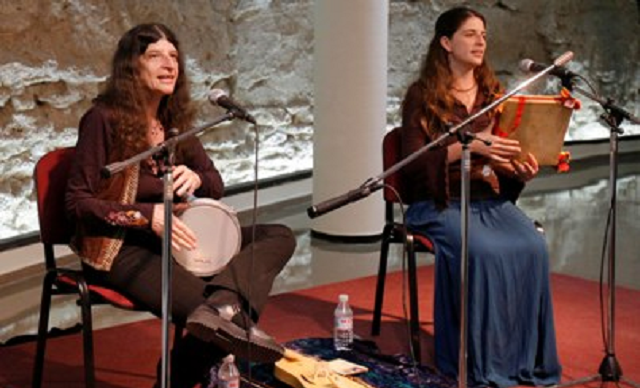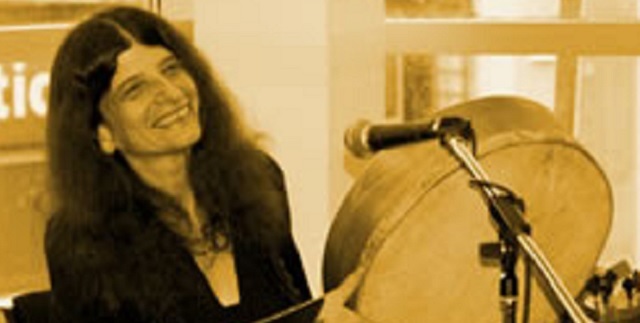EMPEZAR QUIERO CONTAR, CON JUDITH COHEN – En la anterior entrega os hablaba de las canciones del ciclo del año judío. Hoy lo haremos de las canciones, o kantikas, que nos hablan del amor – y a veces del dolor del amor. Algunas de estas canciones son las más conocidas del repertorio sefardí, e – irónicamente – son precisamente éstas las que la gente suele llamar “medievales” y a veces romances. Pero la mayoría de estas canciones tan bonitas ni son romances ni son muy antiguas, sino que son kantikas, y nacieron en la diáspora, mucho tiempo después de la expulsión. Los sefardíes aprendieron algunas de unos cantantes de España, hace un siglo o más; adaptaron otras de canciones populares griegas o turcas o eslavas – o de tangos, foxtrots, charlestones… Algunas sí que tienen letras más antiguas, de España, y, por supuesto, algunas fueron composiciones de los sefardíes. Casi todas estas canticas, estas canciones líricas, son del lado oriental de la tradición judeoespañola, o sea de las zonas ex otomanas: Turquía, Grecia y la ex Yugoslavia (hay unas pocas de Marruecos). Empezamos con una canción muy conocida, “La rosa enflorece” o “Los bilbilicos”, los ruiseñores. La primera grabación que conocemos de esta canción tan famosa, cuya melodía también se utiliza para “Tzur mishelo ajalnu”, es del gran cantor Haim Effendi (Haim Behar Menajem), nacido en Edirne en 1853 y fallecido en Egipto en 1937. Ésta es una de las primeras grabaciones de las canciones en judeoespañol; tiene más de cien años, es de 1907.
Sería difícil hablar de estas canticas sin escuchar la que casi todo el mundo conoce “Adió kerida”. Sus orígenes son algo polémicos (dicen que el gran compositor Giuseppe Verdi les “robó” la melodía a los judíos de Italia: Verdi conocía a algunos judíos, eso sí, pero casi seguro que fue al contrario y los judíos, con su talento habitual para adaptar la música de su entorno, adoptaron esta melodía de “La Traviata” y le pusieron letras nuevas – vyerbos muevos). Y, para una kantika tan conocida, vamos a escuchar a un cantante igual de conocido, cuyas grabaciones han tenido una influencia importantísima, el muy querido Yehoram Gaon, de una familia de linaje sefardí admirable.
Hablando de cantantes y de su influencia, escuchemos ahora al padre de una de las artistas más apreciadas de nuestros días, Yasmin Levy. Su madre, Kojava, es también una gran cantante, y su padre, el sefardí israelí Yitzjak Levy, no necesita presentaciones. Su nombre es casi sinónimo con el “revival” de las canciones judeoespañolas por su gran trabajo de recopilación, su programa en la radio Kol Israel, por sus libros y por sus conciertos y grabaciones.
Vamos a volver a las primeras grabaciones. Son sobre todo las mujeres que cantan el repertorio en ladino, pero la gran mayoría de estos primeros registros eran de hombres. La más conocida de las pocas excepciones fue Victoria Rosa Hazán. Ella nació en Esmirna, y con unos 24 años de edad se trasladó a Nueva York. Cuando falleció en el año 1995 tenía casi cien años, y casi hasta el final seguía cantando, tocando el jumbush y también ayudando a los cantantes que descubrían el repertorio ladino – yo también entre los que hicimos el viaje a Nueva York para visitarla en la residencia sefardí de la tercera edad de Brooklyn. Victoria Rosa Hazan empezó a grabar su repertorio en los años 1940, cantando con un estilo turco.
Hubo mucho movimiento entre las ciudades de Esmirna, Salonica, Constantinopla y otras del imperio otomano en sus últimas décadas. El repertorio griego “rebetiko” se oía en los clubes y las tabernas de Esmirna y Salonica. Y dentro de este repertorio se encuentran dos canciones que hablan de una “evreopoula”, una muchacha judía. En una, un joven describe la “xanthi evreopoula”, la joven judía rubia, que se le roba el corazón. La otra canción titulada sencillamente “Evereopoula”, muchacha judía, tiene implicaciones más serias. Dice el joven: “yo paseaba por el antiguo barrio judío un domingo, vi a una bella judía peinándose con un peine de diamantes; le pregunté si quería convertirse al cristianismo”. El cantante sefardí turco-americano Jack Mayesh hizo una versión en ladino de la primera en los años 40. Antes incluso, en la versión cantada por Rita Abadzi, se oyen unas frases en judeoespañol también. La otra versión, la que quiere que la judía se convierta, la canta aquí Giorgos Vidalis, y las palabras habladas en judeoespañol son de Rosa Eskenazi. Ella era sefardí, y una de las más conocidas cantantes del rebetiko. Nació como Sara Skenazi alrededor del año 1900 en Estambul. La familia se trasladó a Salonica y no les gustaba nada que la hija fuese cantante profesional.
Volviendo a Turquía, en las últimas décadas del siglo XX aparece el grupo “Los Pasharos Sefardis”, dirigido por Karen Gerson – a la que muchos de los oyentes seguramente conocen – y con las voces entrañables de estos buenos amigos (la propia Karen e Izzet Baná), escuchamos “Ven, hermoza”
Menos conocida es Drita Tutunovic, de Belgrado, en Serbia. La conocí un día memorable, con mi hija Tamar: acabábamos de llegar a la ciudad en un autobús nocturno desde Sarajevo y en pocas horas íbamos a coger otro bus nocturno a Sofia, en Bulgaria. Entre un bus y otro, tomamos un helado con Drita, charlamos, nos reímos y ella nos cantó unas cuantas canciones de su familia. Esta es de un disco que grabó con el grupo Shira u’Tfila.
¿Y Marruecos? Pues, como anticipé, la mayoría de estas canticas no son de Marruecos, donde las mujeres seguían cantando el romancero más tiempo que en la zona ex otomana. Pero aquí hay una canción, que aprendimos de Henriette Azen, de Orán y Paris. Se trata de la leyenda antigua del pozo amargo, del amor trágico entre una joven judía y un joven cristiano. La canción se canta en diálogo, entre madre e hija, y así la cantamos mi hija Tamar y yo.
Escuchemos una más de Marruecos, cantada por Alicia Benassayag, en los años 50, antes de emigrar a Israel. La grabó en su Tetuán nativo la etnomusicóloga estadounidense Henrietta Yurchenco. Se oye la palabra en haketía “al-azba”, la muchacha.
Seguramente muchos de entre vosotros estaréis pensando, “¡pero no has puesto mi canción preferida! ¿Dónde están “A la una yo nací”, “Avrishme galanica”, “Durme durme”, “Arvoles lloran”, etc. Es que es imposible incluir todo. Efectivamente, el tiempo se nos acaba, y os dejo ahora, con la voz de Berta – Bienvenida Aguado. Así acabamos el programa de hoy. En el próximo, escucharemos algunas canciones de las circunstancias y los acontecimientos de la vida cotidiana. Hasta entonces, saludos desde Canadá, a todos los de Radio Sefarad, y a todos vosotros oyentes, de vuestra amiga Judith Cohen.
[TEXT IN ENGLISH:
EMPEZAR QUIERO CONTAR, WITH JUDITH COHEN –
- Cantando el dolor y el amor – Singing sorrow and love
Hi, I’m Judith Cohen, from Canada. In the last segment, we listened to songs of the Jewish calendar cycle. Today we’ll focus on kantikas, songs, which speak of love, and sometimes of love’s sorrows. Some of these songs are the best known of the Sephardic repertoire, and, ironically, they are the ones which often are mis-labelled as “medieval”, and also often mis-labelled “romances.” But most of these appealing, often beautiful songs are neither ballads (romances) nor particularly ancient; rather, they are kantikas, created in the diaspora, often a very long time after the expulsion of 1492. Sephardim learned some of them from popular Spanish singers, about a century or a little more ago; they adapted others from popular Greek, Turkish and Slavic language songs, or from tangos, foxtrots, charlston tunes…. Some do have lyrics which are much older, and can be traced back to Spain, and of course some were composed by Sephardim. Almost all these songs, often called lyric songs, are from the former Ottoman region – today’s Greece, Turkey, the former Yugoslavia, Bulgaria; and just a few are from Morocco. Let’s begin with a very well-known song, “La rosa enflorece” or “Los bilbilicos” “the rose blooms”, also known as “the nightingales.” The first known recording of the song, whose melody is also used for the Hebrew “Tzur mishelo ajalnu”, is one by the legendary Haim Effendi (Haim Behar Menajem), who was born in Edirne (Adrianopolis) in 1853, and died in Egypt in 1937. This is also one of the first extant recordings in Judeo-Spanish, made over a century ago, in 1907.
It would be hard to discuss these songs without listening to one which just about everyone who has heard Judeo-Spanish songs recognizes: “Adió kerida”, “good-bye, my beloved [woman]”. The song’s origins have been the subject of some disagreement: it has been said that the great composer Giuseppe Verdi “stole” the tune from local Italian Jews. Verdi did indeed know Jews, but it is far more likely that it happened the other way around, and that Jewish singers, with their usual talent for adapting music of their surroundings, adapted this tune from “La Traviata” and gave it new words– vyerbos muevos. For this emblematic song, we’ll listen to an equally emblematic singer, whose recordings and concerts have exerted an enormous influence on the performance of Ladino songs: the beloved singer Yehoram Gaon, himself from a highly respected Sephardic lineage.
Speaking of singers and influence, let’s listen now to the father of one of the most appreciated artists of our time, Yasmin Levy. Her mother, Kokhava, is also a very fine singer, and Yitzkhak Levy needs no introduction. His name is almost synonymous with the revival of Judeo-Spanish song, through his collections, publications, concerts and radio programme on Israeli national radio, Kol Israel.
Returning to very early recordings: most of them are of men singing, though the Judeo-Spanish repertoire was typically sung more by women.Of the few exceptions, the best known was Victoria Rosa Hazán. She was born in Izmir (Smyrna), and moved to New York City when she was about 24 years old. When she passed away in 1995, she was nearly 100, and she had continued, almost until the end, to sing, play the dzhumbush, and help singers who were discovering the Ladino repertoire – I myself was among the many who sought her out in the Brooklyn Sephardic Home for the Aged where she spent her last years. Victoria Rosa Hazan began to record her songs in the 1940s, singing in Turkish style.
There was a good deal of movement among Izmir/Smyrna, Istanbul/Constantinople, and Thessaloniki/Salonica in the last decades of the Ottoman Empire. The Greek genre “rebetiko” was heard in clubs and taverns of Izmir and Salonica. Among these songs was a couple about the “evreopoula”, the “Jewish girl”. One describes a young blonde Jewish girl, “xanthi evreopoula”, who steals the singer’s heart. Another, referred to simply as “Evereopoula”, tiene has serious implications; the young man sings, “passing by the Jewish quarter I saw a beautiful young Jewish girl combing her hair with a diamond-studded comb; I asked her whether she wanted to convert to Christianity.” The Turkish-American Sephardic singer Jack Mayesh recorded a Judeo-Spanish translation of the first of these two songs, in the 1940s. In an earlier recording by Rita Abadzi, some Judeo-Spanish words appear. Here the song in which the “Evreopoula” is asked whether she wants to convert, is performed by Giorgos Vidalis, with words in Judeo-Spanish sung Rosa Eskenazi. One of rebetiko’s best-known singers, she was Sephardic, born as Sara Skenazi around the year 1900 in Istanbul. The family moved to Salonica, and were not pleased when their daughter became a professional singer.
Returning to Turkey, in the last decades of the 20th century, the group “Los Pasharos Sefardis”, the Sephardic songbirds, was formed. Directed by Karen Gerson – known to many Radio Sefarad listeners – , here are the Pasharos with the appealing voices of these good friends, Karen herself and the inimitible Izzet Baná, singing “Ven, hermoza”, “Come here, pretty one.”
Les known is Drita Tutunovic, from Belgrade, in Serbia. I met Drita one memorable day with my daughter Tamar – we had just arrived in Belgrade on the overnight bus from Sarajevo, and only a few hours later had to catch another overnight bus, to Sofia, Bulgaria. Between buses, we met several people and enjoyed an ice cream and a delightful chat with Drita, who sang a few songs from her family right there at the open-air café. This one is from a recording she made with the Serbian Sephardic group Shira u’Tfila.
And Morocco? As I mentioned, most of these songs are not from Morocco, where Sephardic women continued to sing the old ballads and wedding songs for longer than, for the most part, in the former Ottoman lands. But here is a song which I learned from Henriette Azen, of Orán and Paris. Its story can be traced to the legend of the bitter well, the well of tears, and the tragic love beyween a Jewish girl and a Christian boy. The song is in the form of a mother-daughter dialogue, and I sing it here with my daughter Tamar.
Let’s listen to one more from Morocco, sung by Alicia Benassayag, in the 1950s, before she emigrated to Israel. The American ethnomusicologist Henrietta Yurchenco recorded Alicia and a few other women and men in Tetuan. In the song, we can hear the typical haketía (Moroccan Judeo-Spanish) word “al-azba”, girl, from Moroccan Arabic.
Probably some of you are thinking, “but you haven’t played my favourite song! What about “A la una yo nací”, “Avrishme galanica”, “Durme durme”, “Arvoles lloran”, etc?” But it’s impossible to include everything. In fact, our time is almost over, and we’ll end now, with the wonderful voice of Berta – Bienvenida Aguado. In the next programme, we’ll hear songs of daily life. Till then, greetings from Canada to everyone at Radio Sefarad and all you listeners, from your friend Judith Cohen in Canada. ]




